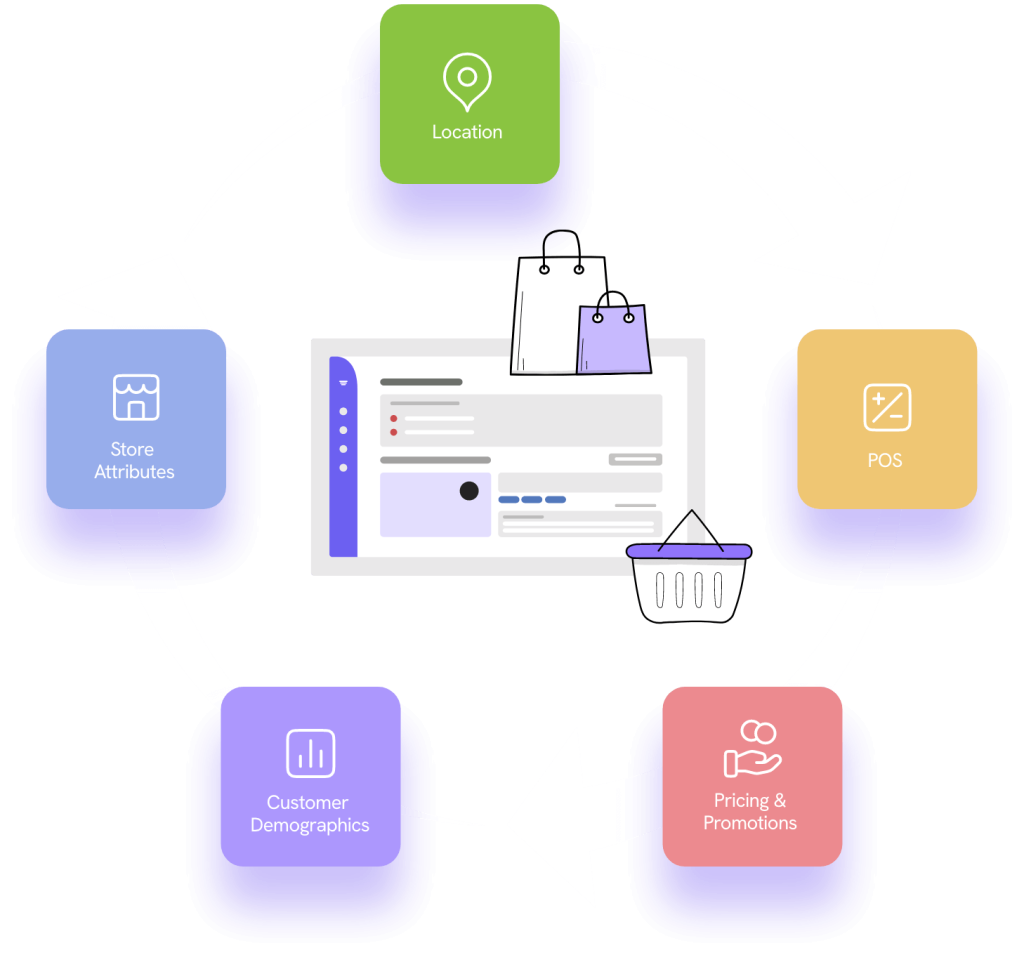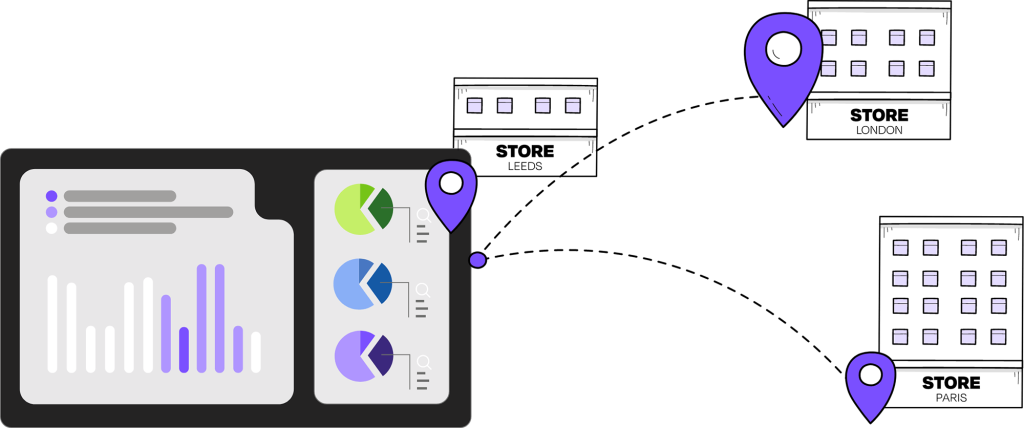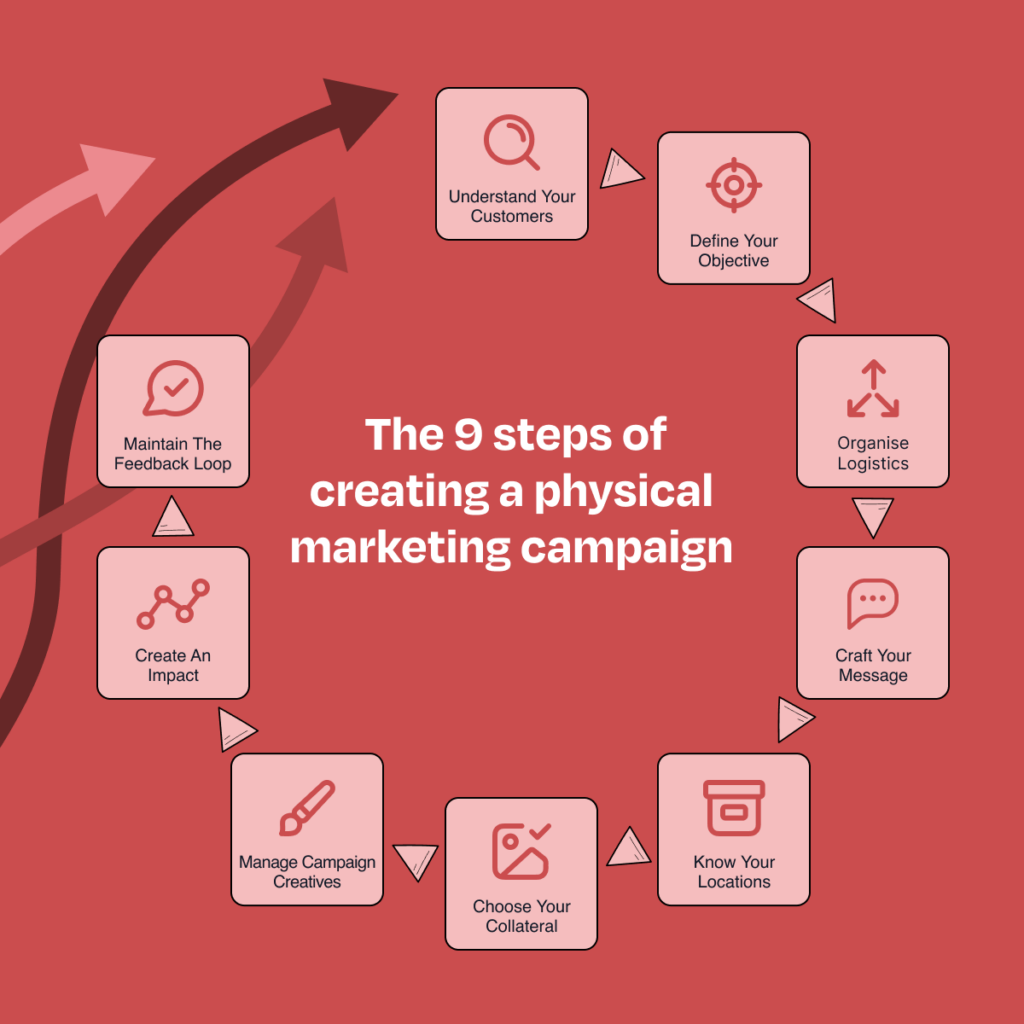Creating a Physical Marketing Campaign: The Complete Guide


This article is an in-depth guide covering everything you need to know about planning a physical marketing campaign. It covers the entire process from the time required to create campaigns through to techniques, tools and tips to build all your in-store promotions successfully.
If you’ve landed on this page, you’re possibly new to multi-site campaign planning, or you’re looking to minimise the time it takes to create your campaigns. Whichever it may be, this blog explores the physical campaign planning process from ideas to execution, with lots of tips along the way.
To break up the information, we’ve split this blog into five key questions:
Contents
A physical marketing campaign involves physical printed or manufactured materials that are used to attract and engage customers. Examples of physical marketing campaigns include direct mail, billboards, leaflets, stickers and the printed marketing materials in commercial locations, such as posters, banners, and other point-of-sale display collateral.
This article focuses on physical marketing campaigns that involve printed or manufactured marketing materials created for in-store or location-based (i.e. banks or restaurants) campaigns. This is also known as in-store advertising, shopper marketing and POS or POP displays.
As a general rule, a physical marketing campaign takes 2-4 weeks to create. Typically, this includes time to plan, allocate materials, produce the content and install the campaign. However, the time to create a campaign is relative to the campaign size, with new product launches and seasonal promotions taking up to 3 months or more, while daily updates can be planned and delivered in a matter of hours.
The tools or technology used, from calendars and spreadsheets to purpose-built platforms, can dramatically impact the time it takes to bring a campaign from initial ideas to reality.
Planning a physical marketing campaign is a complex and often time-consuming process. However, we developed a 9-step system to plan effective physical marketing campaigns every time.
It goes without saying that the first and most important step in planning any campaign is to understand your customers. What will catch their eye in store for this campaign? Which messaging is most likely to encourage a purchase? How will you achieve what you want from your printed marketing materials?
With the accessibility of online product browsing and price comparisons, we know that customers are looking for more personalised and engaging in-store experiences. They are also prioritising value and shopping more healthily and ethically.
Physical marketing campaigns are often structured around seasonal celebrations, we’re talking Thanksgiving, Christmas, Valentine’s Day, Easter… and so on. These are often followed by key retail sales or shopping periods, such as January sales, End-of-Summer discounts, Back to School, Black Friday and Cyber Monday, to name just a few.
Throughout the year, campaign calendars are also peppered with smaller, less significant events (hello World Book Day and Bank Holidays!) alongside specific product promotions and discounts, loyalty programs and collaborations. By understanding your customers clearly, you will know which events to target and which aren’t relevant.
Your sales data (both online and in-store), as well as customer data from your digital channels, can help you to better understand customer behaviour, particularly on a local level, and should inform your physical marketing campaigns.
The customer base surrounding each of your locations will vary, and to offer a more localised experience, you should granularly target your campaign messaging to different locations based on the shopping habits or demographics of your customers in that area.

You can read more about Planning Customer-Centric Marketing Campaigns here.
Whether you want to encourage seasonal purchases, a clear out-of-season surplus stock with great promotions, push a new loyalty program or drive attention to new products to encourage sales, it’s important to define your campaign objective.
You want it to be clear and specific (or SMART), as this will guide your messaging, the types of display materials you use and the locations you run your campaign in.
Specific: Increase total spend/average basket size on Back To School items in stores by X% on last year during the 12 week campaign period.
Measurable: Track the Back To School product purchases per customer/transaction throughout the campaign period.
Attainable: Considering previous sales figures, increasing total spend by X% in Q3 is achievable.
Relevant: This goal aligns with the overall sales goals of increasing store sales by X in Q3.
Time-bound: The deadline is set for the last week of Q3 when the in-store campaign ends.
It’s also good to remind yourself: what does a physical marketing campaign offer that online and other types of advertising don’t? The opportunity to build emotional connections with customers and encourage them to touch and engage with your products.
It would be best if you used your physical campaigns to inspire shoppers with interesting displays, catch them mid-shop and encourage impulse buys, and give them great in-store experiences with eye-catching visuals and clear offers.
With shoppers frequently heading to stores to connect with a brand and its products in-person before making a purchase online at a later date, they are a vital part in the customer journey and you should be telling the same story on all your channels. Your physical marketing campaigns should be used to mirror, compliment or amplify your digital campaigns. For consistent and fluid shopping experiences, there should never be a disconnect between the two.
For more information about this, read our Cross-Channel Campaign Management: online & offline marketing post here.
A critical part of physical campaign planning is working out the logistics. It is often a case of working backwards from the date you need your campaign live in your stores. When do you need your material artwork completed? When does your campaign need to be printed? What date will your suppliers need to ship your physical campaign materials to stores?
Here’s an example of what this might look like:
| Campaign planning start date | 1st June 2023 |
| Campaign artwork deadline | 10th July 2023 |
| Send campaign requirements to supplier | 14th July 2023 |
| Supplier to pack and ship campaign materials | 18th July 2023 |
| Marketing materials must all be in-store | 21st July 2023 |
| Materials installed in store | 22nd July 2023 |
| Campaign launch date in store | 24th July 2023 |
| Campaign end date in store | 23rd September 2023 |
An online calendar of deadlines, accessible and visible across the teams involved in delivering your physical campaign, will help your plans stay on track.
You likely have a regular supplier, or suppliers, for your physical campaign materials, and they’ll provide pricing information to keep you on budget. You’ll need to keep them informed of exactly which materials you need for each location and when.
Miss a campaign delivery deadline, and your in-store customer experience is instantly compromised. Our campaign management tool brings together your key dates and deadlines, artwork management, material specifications and supplier communications and distribution, so you don’t have to juggle shared calendars, endless emails and thousand-line spreadsheets to get your campaigns in motion.
Your campaign message and theme is what ties all your marketing activities together. You want it to resonate with your target audience and focus on tapping into their emotions. If your physical campaign is part of a larger cross-channel campaign, you’ll want everything you create to be consistent and easily recognisable to your customers.
With as many as 82% of purchase decisions made in-store, and up to 80% of customers actively looking for deals in stores, this is your opportunity to showcase certain items and encourage impulse buys.
Overall, your in-store messaging and promotional signage needs to be clear and eye-catching. It needs to tell a story and/or guide your customers effortlessly to their purchase. There’s nothing more annoying for shoppers than being captivated by a great campaign and then it falling short on the finer details. For example, not being able to work out which items are part of an offer because the signage isn’t clear, or seeing something advertised in your direct mailers and then struggling to locate it in store.

In order for your physical campaign to be effective in both cost and impact, you need a comprehensive understanding of the unique requirements of each of your stores. You need to have detailed information about their physical print and display needs (from fixtures and fittings to floor plans and window sizes) and, ideally have data about each store’s locale, from customer demographics to competitor proximity. One way of gathering this information is with a store audit.
The alternative is to send out generic marketing packs, but these can be unnecessarily costly and incredibly wasteful as lots of the materials produced never get used. You also miss out on localising and targeting your campaign content to be most effective in your different locations.
Having an in-depth understanding of your estate, and maintaining up-to-date information about each location’s individual marketing requirements, can be a constant challenge. One that is frequently managed using spreadsheets. Dynamic location management tools, like Colateral’s, can help you to maintain accurate store (or site) data and have it easily accessible and able to be utilised in every new campaign.
To learn more, read our latest ebook, Store Profiling: The Complete Guide here.
When you know exactly which display materials your stores need, selecting the right elements for your campaign is much simpler.
The great thing about physical marketing campaigns is that you can choose from a huge array of display components to guide your customers inside and around your stores. From window posters and shelf talkers to free-standing display units, you have a catalogue of options at your fingertips.
Some display materials work better and are more cost-effective for certain campaigns or promotions than others. You can read our post about the pros and cons of some of the most common types of retail displays here.
If you’re working on the next seasonal campaign, it can be easy to look back on last year and duplicate your materials and distribution method. While this can be a viable and time-saving option if you have the tools to do it quickly and easily (Colateral offers campaign duplication in a click!), we recommend setting time aside to review the effectiveness of your previous campaign.
You want to make sure that whatever you’re repeating will work as well as, or ideally, better than before. Depending on store feedback, you might want to make some tweaks, beyond refreshing the creatives, to improve the overall impact.

Whether you’re starting your campaign from scratch or updating the artwork on a previous campaign, you need to be able to deliver clear creative briefs to your internal or external design team.
Your marketing and creative teams need to be completely aligned to ensure your campaign vision comes to life and timely and costly mistakes (from incorrect product pricing to missing legal information) are avoided. You also need to make sure that your designs are functional and suitable for the physical marketing materials you are using. Clear approval processes, with full traceability, can help you to have complete visibility and peace of mind.
You might also want to take localisation one step further and allow your stores to personalise content for their location. Not only does this help to better connect with customers on a local level, it also allows store teams to utilise location-specific knowledge in your marketing.
At Colateral, we help our customers to simplify the complete campaign artwork process as well as create on-brand templates that can be edited by store teams within certain parameters, before being forwarded to suppliers for manufacturing. No more post-it notes and back and forth emails to approve campaigns, no more wondering who did what and when, and more relevant content in every location!
Next stop, campaign communication. Your in-store employees are a key part of your retail marketing plan and campaigns. In order for your physical campaign to have the desired impact, you need to make sure your remote teams are well informed of your campaign plans. This ensures your campaign will be executed on time, and in the way that it was designed. It also means that they’ll be able to provide excellent customer service as they know what promotions are happening in-store.
You also want to know that if your marketing materials or display items are missing or damaged, your store teams will quickly notify you – or your suppliers directly – that they need to be replaced. This is key to maintaining a great experience in every location.
All of this comes down to having solid communication between your local teams and your marketing team in head office. As well as providing easy-to-interpret display instructions.
Read more about this in our post about Why good on-site communication is vital in retail.
Information about your physical marketing campaigns shouldn’t just be a top-down approach. In order to improve your future campaigns, you need your store teams to be able to share both quantitative and qualitative data with you about your campaign, and its effectiveness.
As well as collecting store data, store auditing is a way of checking your campaigns on an ad-hoc basis. But, to have a really clear picture of what’s happening across your estate and what your campaigns look like in different locations, display compliance tools like Colateral’s can give you that feedback in real-time.
Physical marketing campaigns are harder to measure the effectiveness of than digital campaigns. Generally, you can do it by comparing product sales data during campaign periods against non-campaign periods. Other options include featuring in-store only QR codes or discount codes on your marketing materials and tracking engagement. All of these techniques rely on campaigns being installed accurately in every location.
Campaign planning should be constantly evolving. From updating the marketing requirements and information in store profiles to targeting materials to different locations and tracking implementation. And finally, to gaining insights into campaign performance and feed that into the next campaign. It should be a cycle of learning and improvement.

As a general rule, physical marketing campaigns in stores last between a few weeks to three months. The length of physical marketing campaigns in stores depends a lot on the type of campaign.
Seasonal marketing campaigns, such as Christmas, may start in stores three or four months in advance of the holiday. Meanwhile, Black Friday campaigns last for just a few days. Clearance sales, like January Sales, may last from a few days to the entire month. Research has found that in-store discounts tend to be most effective in the first five weeks that the campaign runs.
Tools used by a third party or an internal team to collect specific data about each location during in-person visits, often using questionnaires and photographs. This can help retailers (and other multi-site businesses) have a better understanding of the marketing requirements (amongst other things) in each location.
A database which holds detailed information about each store or location. This can be used to more accurately produce marketing materials and plan technology/furniture updates and refurbishments. It is often fed with data from an audit.
Tools to help retailers or suppliers build out the required materials for an in-store campaign.
Tools to manage campaign artwork from briefing to amendments and approvals.
Tools to help head offices communicate with their remote teams about upcoming and current campaign plans and/or display instructions. Generally, if this is two-way communication, it can also be used to check campaign display compliance. Head office can request installation confirmation and/or photos for each campaign.
Colateral combines and interlinks all of the above and more, to offer completely streamlined planning, delivery and optimisation of your physical marketing campaigns. If you’re looking to replace existing processes or introduce new ways of working, our article about Choosing An In-store Marketing System provides more detailed information and guidance.
To find out more about Colateral, please get in touch, and our team will be happy to help.
To receive weekly in-store marketing insights like this direct to your inbox, subscribe to our mailing list.
 Retail, Thought Leadership
Retail, Thought Leadership
As the retail media landscape evolves, retailers are looking where to focus their investments, and...
 News, Retail, Thought Leadership
News, Retail, Thought Leadership
I didn’t choose to acquire this company based on data—it was personal. My grandparents ran...